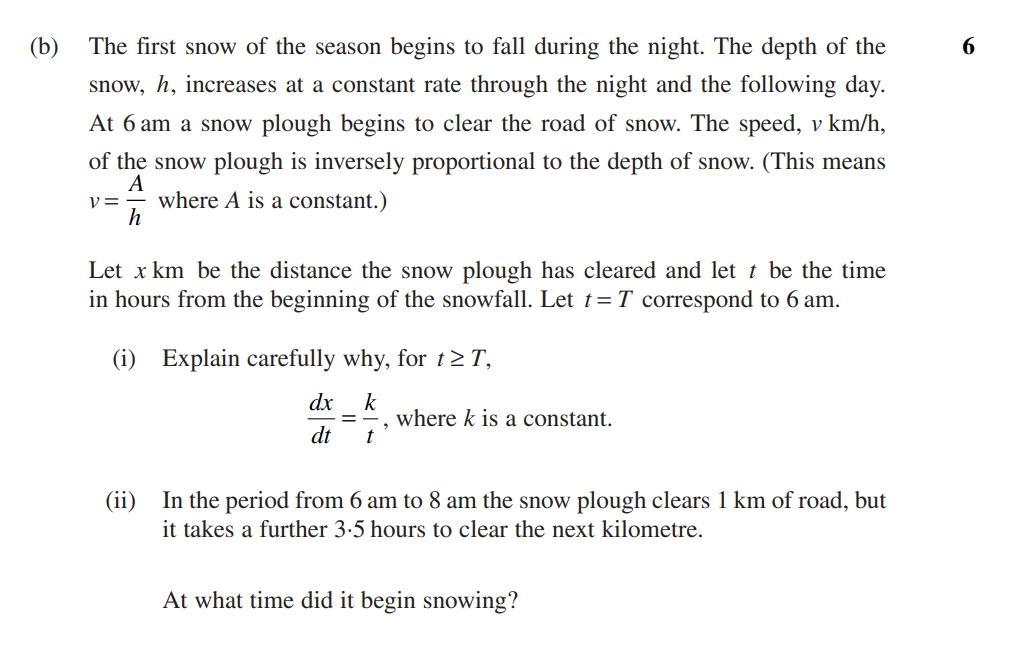AI tutor
Welcome to Bytelearn!
Let’s check out your problem:

(b) The first snow of the season begins to fall during the night. The depth of the snow, , increases at a constant rate through the night and the following day. At am a snow plough begins to clear the road of snow. The speed, , of the snow plough is inversely proportional to the depth of snow. (This means where is a constant.) Let be the distance the snow plough has cleared and let be the time in hours from the beginning of the snowfall. Let correspond to am. (i) Explain carefully why, for , , where is a constant. (ii) In the period from am to am the snow plough clears of road, but it takes a further hours to clear the next kilometre. At what time did it begin snowing?
Full solution
Q. (b) The first snow of the season begins to fall during the night. The depth of the snow, , increases at a constant rate through the night and the following day. At am a snow plough begins to clear the road of snow. The speed, , of the snow plough is inversely proportional to the depth of snow. (This means where is a constant.) Let be the distance the snow plough has cleared and let be the time in hours from the beginning of the snowfall. Let correspond to am. (i) Explain carefully why, for , , where is a constant. (ii) In the period from am to am the snow plough clears of road, but it takes a further hours to clear the next kilometre. At what time did it begin snowing?
- Given Information: We are given that the speed of the snow plough, , is inversely proportional to the depth of the snow, , which means , where is a constant. We also know that the depth of the snow increases at a constant rate, so is directly proportional to , the time since the beginning of the snowfall. Therefore, we can write , where is a constant of proportionality.
- Speed and Depth Relation: Since and , we can substitute in the expression for to get . The distance that the snow plough clears is the integral of its speed over time, so . Therefore, . We can see that is inversely proportional to , and since and are constants, we can write , where is a new constant that combines and .
- Distance Cleared Calculation: We are told that the snow plough clears km of road from am to am. This is a -hour period, so we can set up an integral from to (where is the time corresponding to am in hours since the beginning of the snowfall) to find the distance cleared: .
- First Integral Calculation: Solving the integral, we get evaluated from to . This gives us .
- Second Integral Calculation: We also know that it takes a further . hours to clear the next kilometre. So, we set up another integral from to to find the distance cleared: .
- Equations Setup: Solving this integral, we get evaluated from to . This gives us .
- Equations Solution: We now have two equations with two unknowns, and :. . We can solve these equations simultaneously to find the values of and .
- Final Time Calculation: Divide the first equation by the second to eliminate :This simplifies to:Using the properties of logarithms, we can further simplify:
- Final Time Calculation: Divide the first equation by the second to eliminate :This simplifies to:Using the properties of logarithms, we can further simplify:Since the natural logarithm is a one-to-one function, we can equate the arguments of the logarithms:Cross-multiply to solve for :Expand and simplify:Subtract from both sides and combine like terms:Divide by . to solve for : or approximately hours.
- Final Time Calculation: Divide the first equation by the second to eliminate :This simplifies to:Using the properties of logarithms, we can further simplify:Since the natural logarithm is a one-to-one function, we can equate the arguments of the logarithms:Cross-multiply to solve for :Expand and simplify:Subtract from both sides and combine like terms:Divide by . to solve for : or approximately hours.Since corresponds to am, we need to subtract from am to find the time it began snowing. If is approximately hours, then the snow began falling around : am (since hours is approximately minutes).
